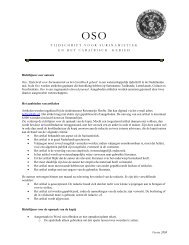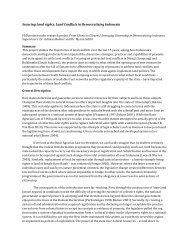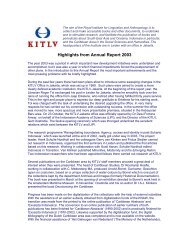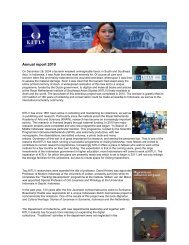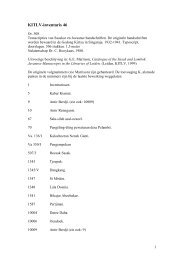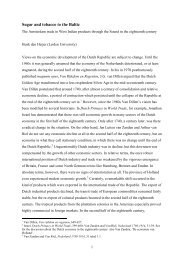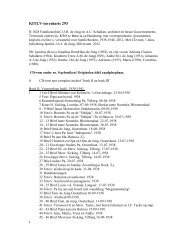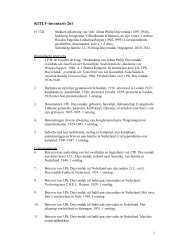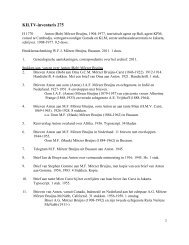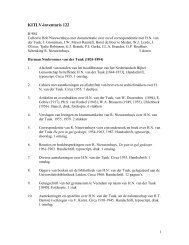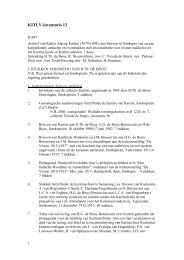The Acehnese past and its present state of study R. Michael ... - kitlv
The Acehnese past and its present state of study R. Michael ... - kitlv
The Acehnese past and its present state of study R. Michael ... - kitlv
Create successful ePaper yourself
Turn your PDF publications into a flip-book with our unique Google optimized e-Paper software.
<strong>The</strong> <strong>Acehnese</strong> <strong>past</strong> <strong>and</strong> <strong>its</strong> <strong>present</strong> <strong>state</strong> <strong>of</strong> <strong>study</strong> 3<br />
<strong>of</strong> Perlak, is known locally as Cot Meuligue – a name that may be derived<br />
from the Tamil malikai (‘palace’ or ‘temple’). 4 Despite calls for further work<br />
on this site published over two decades ago, very little has been done, <strong>and</strong><br />
Lamri, Cot Meuligue <strong>and</strong> other heret<strong>of</strong>ore understudied sites remain long<br />
overdue for a systematic archaeological survey (McKinnon 1988:121). With<br />
the openness <strong>of</strong> post-confl ict Aceh, new possibilities for the exploration <strong>of</strong><br />
Aceh’s archaeological heritage now <strong>present</strong> themselves.<br />
This volume thus begins with a <strong>state</strong>-<strong>of</strong>-the-fi eld review <strong>of</strong> early <strong>Acehnese</strong><br />
history by Daniel Perret. Drawing upon existing archaeological survey<br />
data, as well as early textual materials in Chinese, Javanese, Armenian <strong>and</strong><br />
European languages, Perret <strong>present</strong>s an overview <strong>of</strong> early urban settlements<br />
in Aceh. <strong>The</strong> picture that emerges from this is one <strong>of</strong> a complex constellation<br />
<strong>of</strong> trading ports with far-fl ung connections across both the Indian Ocean <strong>and</strong><br />
the South China Sea. However, much work remains to be done in order to<br />
better underst<strong>and</strong> the particular patterns <strong>of</strong> exchange <strong>and</strong> relations centred<br />
on these North Sumatran nodes in broader regional commercial <strong>and</strong> cultural<br />
networks. Perret’s essay points to some practical avenues for pursuing such<br />
work through his catalogue <strong>of</strong> over a score <strong>of</strong> sites in Aceh requiring more<br />
systematic archaeological investigation, as well as through his assessment <strong>of</strong><br />
analogous work already done in the neighbouring area <strong>of</strong> Barus.<br />
During the thirteenth century, the various settlements along the coasts <strong>of</strong><br />
northern Sumatra appear to have been largely autonomous under the rule<br />
<strong>of</strong> various coastal ‘rajas’. It appears that during this period, some <strong>of</strong> these<br />
ports, including Perlak, were being established under Muslim rule. <strong>The</strong> earliest<br />
Islamic sultanate in the region for which we have any signifi cant surviving<br />
sources was established at Pasai (on Aceh’s north coast) at the end <strong>of</strong> the<br />
thirteenth century. This area is particularly rich in early stone monuments in<br />
the form <strong>of</strong> grave markers (Illustration 2), which have attracted considerable<br />
scholarly attention. Elizabeth Lambourn, for example, has produced groundbreaking<br />
work on both the importation <strong>of</strong> South Asian models <strong>of</strong> Muslim<br />
funerary monuments <strong>and</strong> the development <strong>of</strong> local traditions <strong>of</strong> Muslim grave<br />
markers in the region (Lambourn 2003, 2004). More recently, Claude Guillot<br />
<strong>and</strong> Ludvik Kalus have produced a comprehensive catalogue <strong>of</strong> inscriptions<br />
from the major cemeteries on Aceh’s north coast, dating from c. 1400 to 1523.<br />
<strong>The</strong> catalogue is complete with identifi cations <strong>of</strong> Qur’an, Hadith, poetry, <strong>and</strong><br />
other texts in their inscriptions, as well as a proposed new typology <strong>of</strong> forms<br />
(Guillot <strong>and</strong> Kalus 2008). Nearly half <strong>of</strong> the book, however, is taken up by<br />
essays advancing new interpretations <strong>of</strong> this data, in which they reconstruct<br />
the genealogies <strong>of</strong> Pasai’s rulers in ways that challenge established recensions<br />
4 I would like to thank Ronit Ricci for her help in identifying <strong>and</strong> transliterating this Tamil<br />
term.




